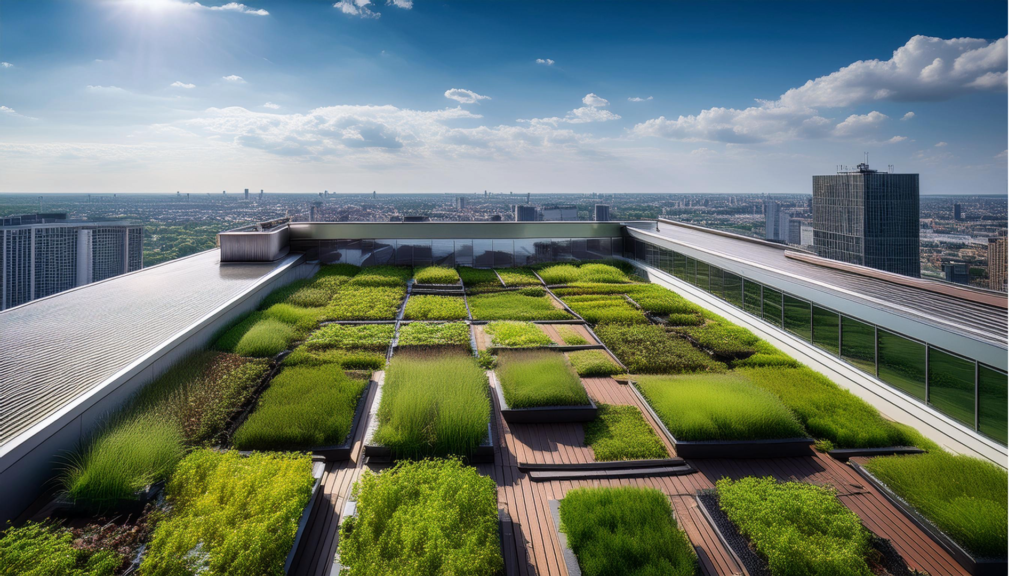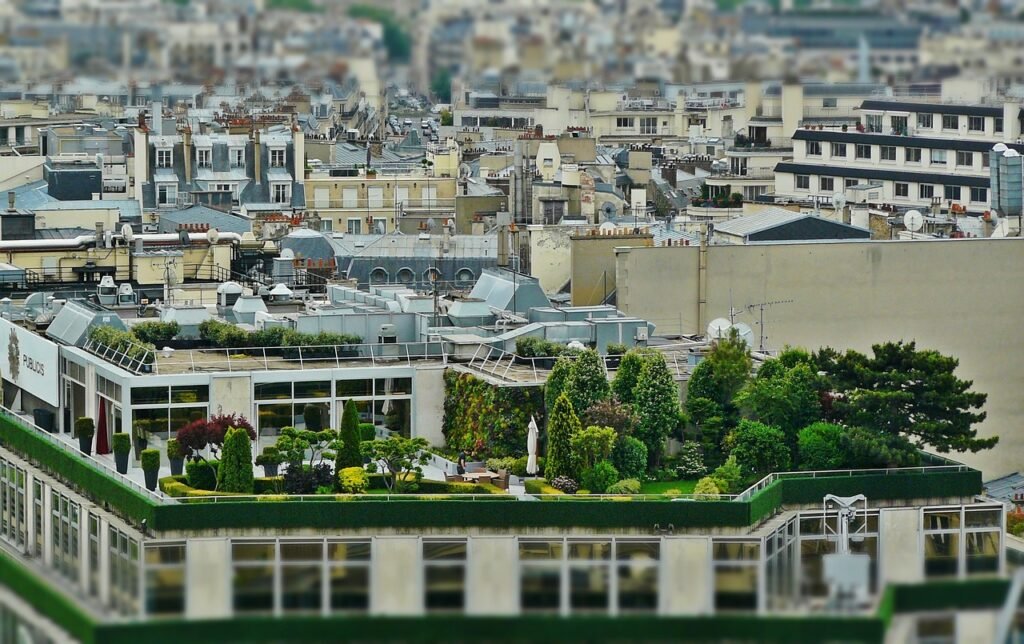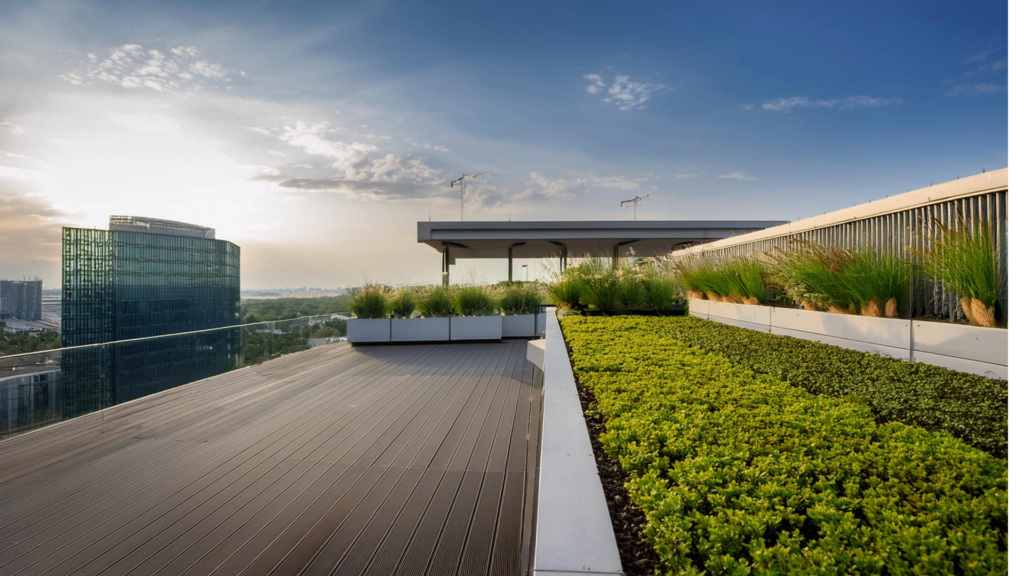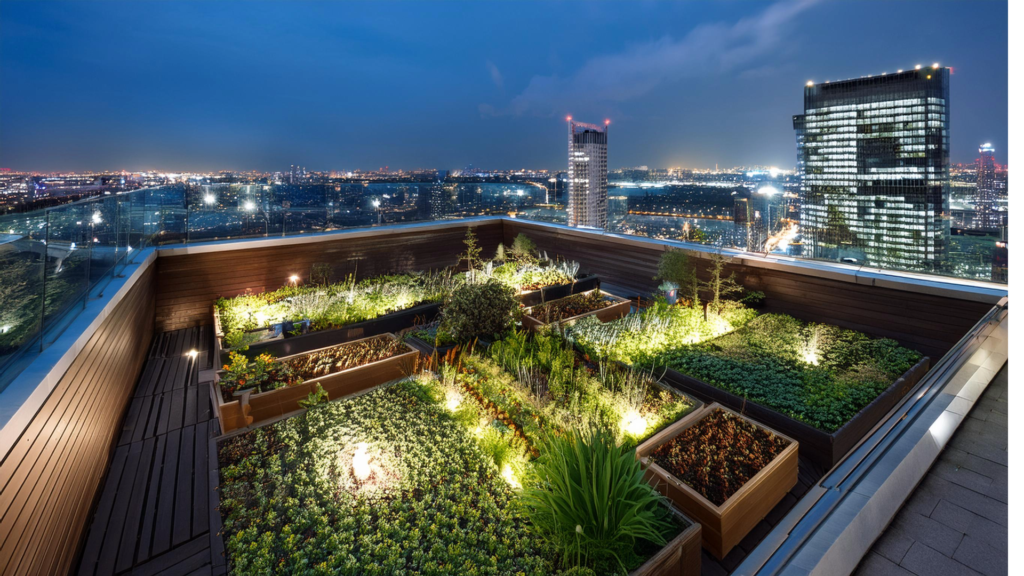What would you do if the building you worked or lived in had a green roofs and a garden? Would you use it?
Green Roofs on Commercial Buildings
Rooftop gardens are gaining traction as a sustainable architectural solution. By integrating plant life into urban environments, green roofs offer numerous benefits, from reducing energy consumption to enhancing biodiversity. Let’s explore the concept of green roofs, their advantages, challenges, and the impact they can have on commercial buildings and urban areas.
What is a Green Roof?
A green roof, also known as a living roof, consists of a layer of vegetation planted over a waterproofing membrane and a series of supporting layers.

5 Main Components of a Roof Green Space Include:
1. Vegetation Layer: The top layer consisting of plants, grasses, shrubs, or even small trees.
2. Growing Medium: A specially designed soil or substrate that supports plant growth while being lightweight.
3. Drainage Layer: Ensures excess water is directed away from the roof structure to prevent waterlogging and structural damage.
4. Filter Fabric: Prevents soil from washing away and allows water to pass through to the drainage layer.
5. Waterproof Membrane: Protects the building from water infiltration and damage.

Benefits of Green Roofs
Energy Efficiency:
Thermal Insulation: Green roofs provide excellent insulation, reducing the need for heating in winter and cooling in summer. The vegetation layer acts as a thermal barrier, lowering energy consumption and utility costs.
Urban Heat Island Mitigation: By absorbing and reflecting sunlight, green roofs help reduce the urban heat island effect, which causes cities to be significantly warmer than surrounding rural areas.
Stormwater Management:
Rainwater Absorption: Green roofs absorb and retain rainwater, reducing runoff and alleviating pressure on urban drainage systems. This can help prevent flooding and waterlogging.
Water Filtration: As rainwater percolates through the layers of the roof, it is filtered, improving water quality before it reaches the drainage system.
Biodiversity Enhancement:
Habitat Creation: A green roof creates new habitats for various species of birds, insects, and plants, promoting urban biodiversity and supporting ecosystem health.
Pollinator Support: They provide vital resources for pollinators such as bees and butterflies, which are essential for the health of urban and rural ecosystems.
Improved Air Quality:
Pollution Reduction: Plants on a green roof absorb pollutants, such as particulate matter and nitrogen dioxide, improving overall air quality in urban environments.
Oxygen Production: Vegetation contributes to oxygen production, enhancing the health and well-being of urban populations.
Aesthetic and Recreational Value:
Visual Appeal: Green roofs can transform an otherwise unused space into an attractive and lush landscape, improving the visual appeal of commercial buildings.
Recreational Space: Some green roofs are designed as accessible spaces for employees and tenants, offering areas for relaxation, socialization, and recreation.
Building Longevity:
Roof Protection: Green roofs can extend the lifespan of roofing materials by protecting them from harsh weather conditions, UV radiation, and temperature fluctuations.

Challenges of Green Roofs
Initial Costs:
Installation Expenses: Green roofs involve significant upfront costs, including installation, design, and materials. The initial investment can be a barrier for some commercial property owners.
Maintenance Costs: Ongoing maintenance is required to ensure the health of the vegetation and the functionality of the roof system, adding to long-term expenses.
Structural Considerations:
Load-Bearing Requirements: Buildings must be structurally capable of supporting the additional weight of the green roof, including the growing medium, plants, and water.
Engineering and Design: Proper design and engineering are crucial to address factors such as drainage, waterproofing, and plant selection.
Climate and Plant Selection:
Climate Adaptation: Plants must be chosen based on the local climate and environmental conditions. In extreme weather regions, selecting appropriate plant species and ensuring adequate irrigation can be challenging.
Maintenance Requirements: Different plants have varying needs for water, light, and nutrients, which can affect maintenance and upkeep.
Regulatory and Permitting Issues:
Building Codes: Compliance with local building codes and regulations may be required, which can involve navigating complex permitting processes and ensuring adherence to standards.

Practical Applications
Urban Buildings:
Office Buildings: Green roofs can enhance employee well-being, reduce energy costs, and contribute to corporate sustainability goals.
Retail and Commercial Spaces: Improved aesthetics and potential for attracting customers can benefit retail and commercial establishments.
Public Buildings:
Cultural Institutions: Museums, libraries, and cultural centers can use green roofs as educational tools and community spaces.
Government Buildings: Green roofs on public buildings can serve as models for sustainability and environmental stewardship.
Residential Developments:
Mixed-Use Buildings:Incorporating green roofs in residential-commercial complexes can enhance property value and offer recreational spaces for residents.

Green roofs on commercial buildings represent a forward-thinking solution that blends sustainability with urban development. By providing energy efficiency, stormwater management, enhanced biodiversity, and improved air quality, green roofs offer significant environmental and economic benefits. Despite challenges such as initial costs and maintenance, the advantages make green roofs a valuable investment for commercial properties aiming to contribute to a greener, more sustainable urban future.

Our view of green roofs is our own. We recommend consulting the AIA and other professional architectural and engineering groups for data from experts who are building these types of roofs today.
Would you want to use a green roof in a commercial or public setting?